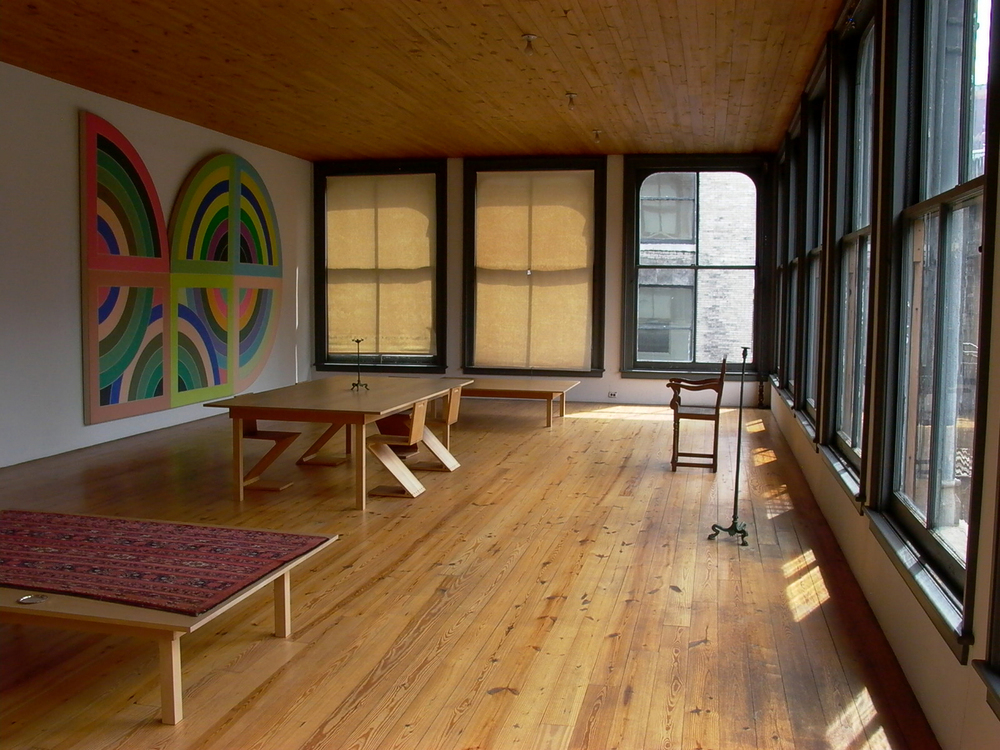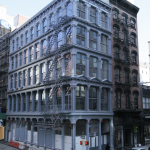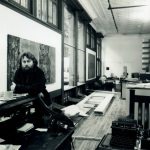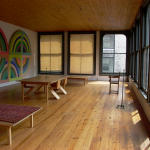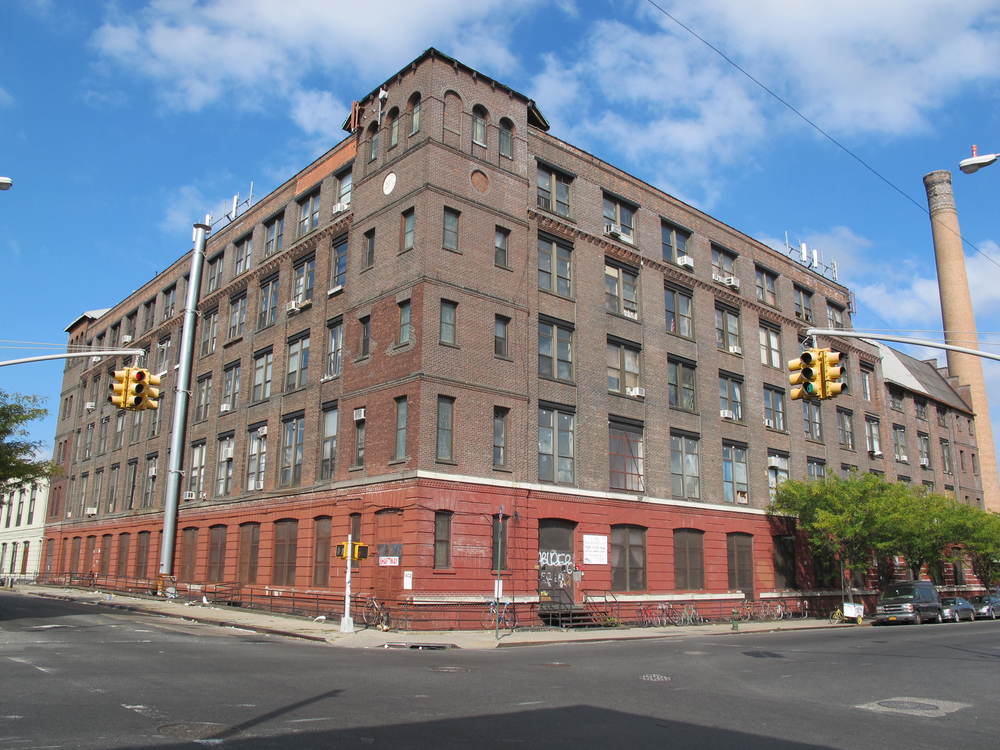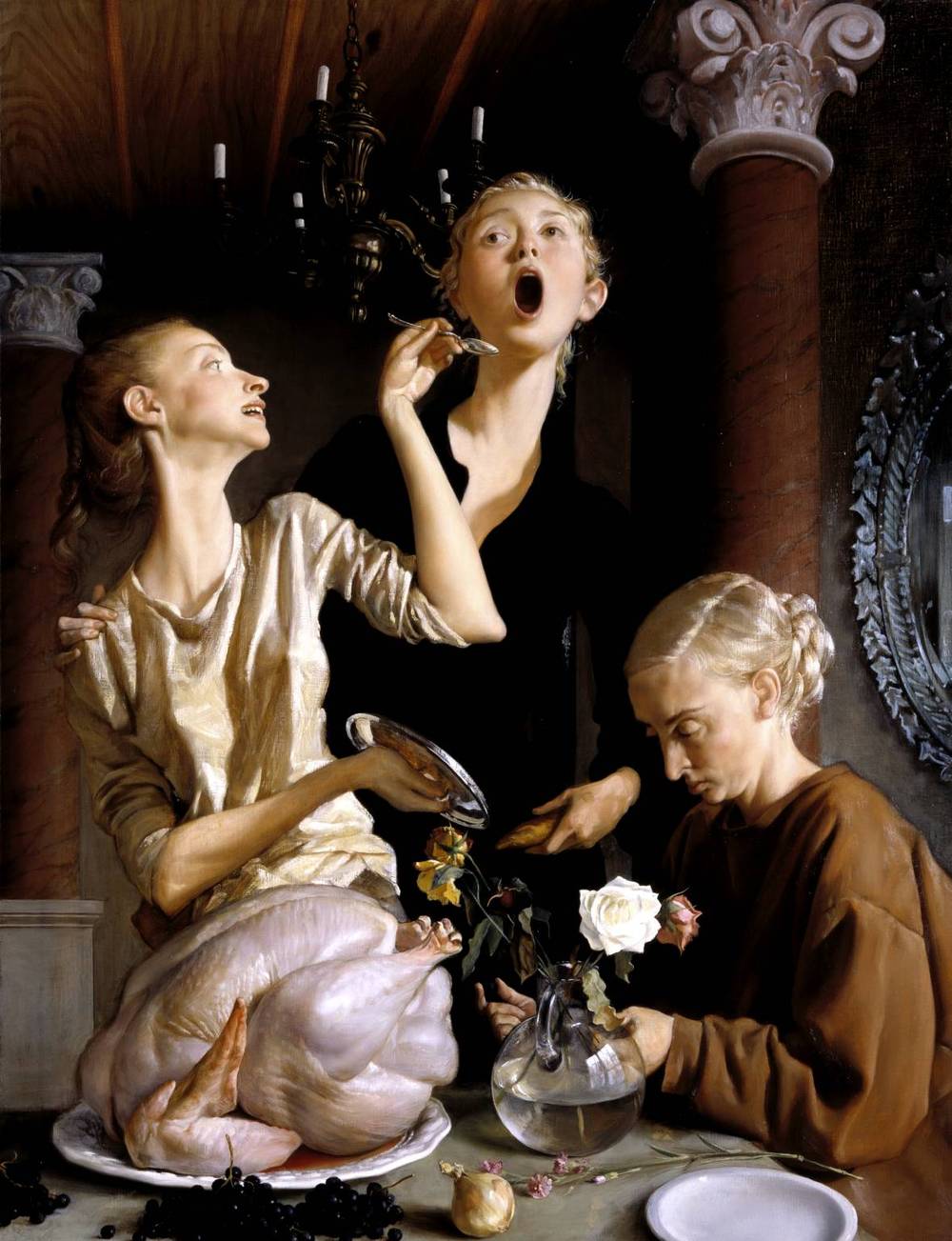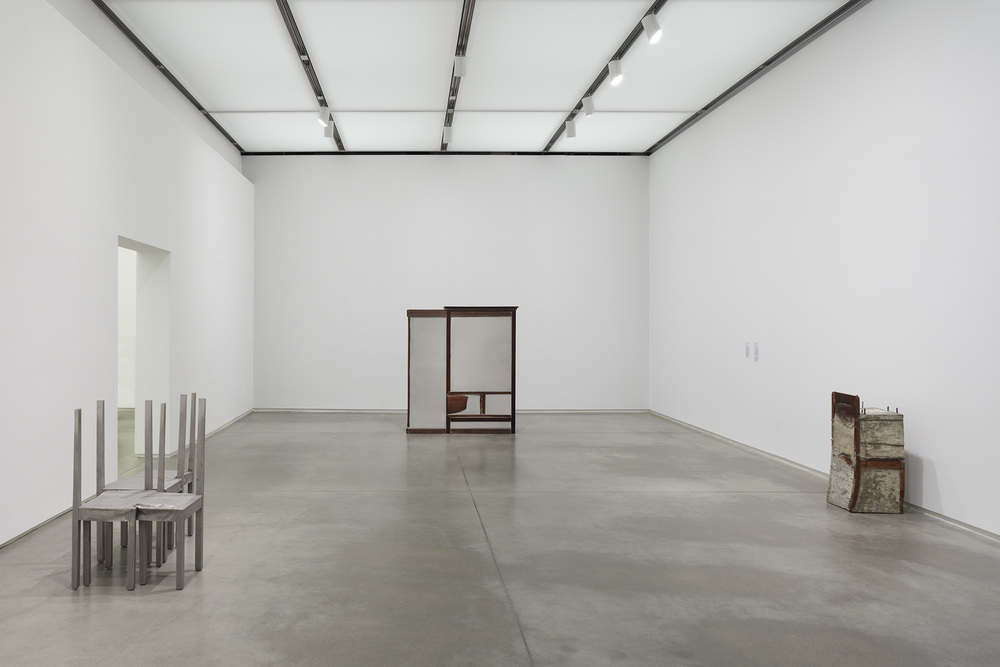Judd’s first solo exhibition was in 1957 at the Panoramas Gallery, New York, showing abstract paintings derived from the landscape. The same year he began graduate studies in art history at Columbia University. Over the next decade, Judd worked as a writer and critic in parallel with his artistic practice. During that time he refined not the focus of his work, moving from painting to relief and independent three-dimensional structures.2 Despite hating the term, his work came to be emblematic of Minimalism, and he achieved renown and financial independence as a sculptor. He also began developing his ideas on large-scale art and its installation and presentation in relation to architecture. These ideas were further enhanced as he bought the five story cast iron3 building at 101 Spring Street in Soho in 1968 and began its renovation, and had the space to put these ideas into practice. He came to believe that the industry of exhibiting art was not to the ultimate benefit of the artist’s vision, and that to be seen properly it should be installed permanently to the wishes of the artist.4 Eventually he tired of New York and started looking for less constricting spaces in which to settle and work. In 1972, the same year that he started having Peter Ballantine fabricate his plywood works, he drove a truck full of his work to Marfa, Texas, making that his home base from then on.
My experience of works of art growing up in the Midwest5 was very limited. I always drew, and this was encouraged by my parents, but mostly only to the extent that it was something to keep me occupied.6 Trips to a museum were non-existent, and it was assumed that drawing and art would be put away as I got older and found a reasonable profession. As I grew a little older and started developing my own tastes and interests, I gravitated toward trips to the convenience store to buy comics. My obsession with collecting and drawing them only increased7 and it gave me a way to focus my creative energies; I more or less tried to draw my way through my adolescence.8High school didn’t help matters as the art department consisted of one teacher who focused on graphic design and the other who took a severely restricted academic approach. For her art was something that decorated churches, and there was no discussion of the history of art beyond that. Needless to say, I spent a great deal of time trying to express myself through typefaces, illustration, and packaging design. It wasn’t until we had a career fair visit from an art school that I was even asked if I had considered art as a career. Once I was asked, I did not grow out of comics, and as I finished high school and headed to college those rows and stacks of boxes with wonderful stories inside lead me to art.9
My college education as envisioned by my parents was intended to give me a broad academic background, and I was saved from being funneled into a design program by the University of Minnesota’s bizarre academic organization.10 Finally left more or less to my own devices11 I started trying to catch up with art and art history. Trips to the museum were still alien (and somewhat inconvenient for being housed far away and at the mercy of Minneapolis’s bus system) so instead I immersed myself in the incredible collection of monographs in the art history library. I started with Van Gogh and just started reading forward into art history as new interests grabbed me. I worked through Picasso and European modernism through to the New York school, absorbing and learning about the work through the gorgeous full color-plate reproductions.12 As I took up painting in earnest, I leapfrogged into neo-expressionism and gestural figuration.13
Minimalism and the art of the sixties and seventies remained a blind spot. Partly owing to the lack of good books on the subject14 as well as both a critical distance in the discourse that filtered into the Midwest at the time, and my own proclivities, I found the work kept me at a distance. Even as I moved to art school and then graduate school—becoming an avowed abstract artist and stripping my practice of narrative, figuration, and any extraneous compositional elements—I remained uninterested in the work. Part of this stems from how important process and revision were to my practice, and in addition to fetishizing the actual labor spent making a piece, I was deeply invested in personal touch and craft. The minimalist ethos (practically synonymous with Judd) of machined surfaces ordered from a fabricator was seemingly designed to limit my interest. It certainly did not help that the few examples I was able to see in person where often not installed in sympathetic environs. The piece I saw most often while an undergraduate was a large stack owned by the Nelson Atkins Museum, which was installed in a hodgepodge of mostly unrelated "contemporary" objects.15 But I always felt like I should like Judd, that the work was a taste worth acquiring. As discovered my own sensibility, the painters coming out of minimalism were the most important to me16 and it was impossible to not look back to the context they emerged from and see how that generating sensibility related to my own interests.
Finding myself across the street from Judd’s former studio at 101 Spring Street with a few other members of my graduate-school seminar, standing under an awning to avoid the rain on a cold, gray day with not much an idea of what to expect. This was not a tour of the studio of a working artist, but the studio of one who famously had his work fabricated elsewhere. We were met by Judd's longtime carpenter, Peter Ballantine, and directed into the space on the first floor. It housed works by Judd and other artists, installed simply in an otherwise plain room, but with an eye toward the specific intentions of the artist. We listened as Peter gave a brief introduction, explaining how Judd came to art through the study of philosophy and writing criticism and the importance Judd ascribed to the proper installation of works of art, and got a brief overview of his career trajectory. Standing next17 to a small Carl Andre stack of bricks that was already leaning in a way that seemed more than just a little precarious made for a more nerve-wracking experience than your standard art history lecture. Peter told us of the building’s history, how Judd was engaged with the particular cast iron architecture,18 and how he almost bought another building before deciding on 101 Spring Street. The ground-floor space was originally his studio, but that was ultimately relocated to another floor, when friends stopping by and knocking on the window to go get a drink proved to be too much of a distraction.
The tour was nothing if not meticulous and thorough and seemed designed to counter misconceptions about the artist born of shallow misreadings of the work or easy stereotypes. Sitting on the first floor was a wood box with a hollow pipe set into the top plane. The genesis for the design had been a friend giving him the material, which was actually the aluminum mast from a sailboat. The details were humanizing, showing a sense of fascination with materials and process that were different than my own, but still directed toward understanding how abstract forms serve as a means of personal expression. The entire Spring Street building served as an extension and vehicle for him to not only work toward realizing this in his art, but understand how it might be applied over his entire life. The point was (perhaps unintentionally) driven home as our group crowded into a bathroom of spartan simplicity, to be informed that Judd was ultimately limited by what he could do with the plumbing of the building, and was disappointed that the room housed multiple facilities (sink, tub, and toilet). When he had the opportunity to fully outline his vision in Marfa, he was able to separate them into distinct areas.19 My immediate and lasting thought was that for people who complain that minimalism removed personal expression from art, "he was really like that!" It was how he related and responded to the world, inclusive of geometry, philosophy, and the everyday materiality.
The details of the tour meshed seamlessly with the works and furnishings20 of the building. The precision and order of the each space was expected, but there were also surprises. Judd preferred to work standing at an architect’s desk, and only by natural light. He hated to be disturbed while working,21 but was not so strict as to be unable to accommodate and incorporate the world into his work.22 The building also contains fantastic examples of works by other artists. Early paintings by Frank Stella are prominent, and several works are not necessarily common in exhibition, such as early Flavin ‘Icon’ boxes or a fantastic mural by David Novros.23 The tour finished on the fifth-floor bedroom, with a monumental Flavin running the incredible length of the westward facing windows. I remember the setting sun providing incredible color, but can’t remember if the Flavin was turned on.
We headed down the street to Fanelli’s for drinks; I was undeniably excited. I stepped onto the corner of Spring and Mercer with a whole new understanding and appreciation for Judd. In the space of a modest three-hour tour, his work had transformed from poor reproductions into a sculptural practice that I found to be much closer to my own sensibility than I ever would’ve guessed. The idea that so much of an artist’s practice can remain opaque in the face of vast documentation underscored the importance of harnessing a specificity of vision.
I moved to New York shortly thereafter to start my own career as a practicing artist. As the art world has continued its ceaseless migrations around and through the city, I find myself in SoHo less and less, but every time I pass the high windows on Spring Street with the simple text announcing the Judd Foundation, I think about knocking on the window, and smile.
The Judd Foundation has completed renovations to 101 Spring Street and it will be open for guided visits in June, 2013. For more information contact the Judd Foundation at nytours@juddfoundation.org with any inquiries.
[1] With the benefit of hindsight, early biographical details become almost unbearably portentous; how much this is a result of selection bias or projection on our part looking back is open for debate, but it is also mostly the point of this essay.
[2] Judd disavowed much of his pre-60s work as "stupid." His catalogue raisonné excludes anything produced before 1960, but previous examples are extant. (See Donald Judd, The Early Works 1955 - 1968, organized by the Kunstalle Bielefeld and Menil Collection, where the point is to show is to provide a novel glimpse of what Judd made before he was "Donald Judd." However, even then there is more work that explores the genesis of Minimalism than examples of student work.) He made his first freestanding object in 1962. He described it as "a big deal for me" and it came from working on a relief that he set on the floor (presumably while working on it in the studio) and ultimately left it there as "being on the floor didn’t seem to bother it."
[3] Cast iron architecture was prevalent in the mid to late 1800s, and was prized for its utility. In considering the direction of art in New York City, it is important to note that the strength of the metal allowed for much larger window frames, and better illumination for the manufacturing and light industry that occupied the lofts in lower Manhattan. 101 Spring Street, like many of the spaces in Soho and Greenwich Village, was originally a garment factory.
[4] Of course Judd would only expect it to be done to the artist’s specifications, not demand that the artist do it themselves.
[5] While I was born in the West, and first started school in the East before our family settled in Minnesota, the only thing that changed the sameness of the suburban environments was the weather. When asked where I feel I am "from," I invariably answer "Minnesota."
[6] Looking back, my environment stands out as a giant aesthetic blank spot. There was almost never music playing in the house (except perhaps for holiday music around Christmas) and even the few framed pictures that weren’t of family members were from my father’s photography hobby which seemed decades old. Aesthetics and art just weren’t a part of my environment growing up.
[7] . . . or got worse, if you asked my parents.
[8] My early efforts were limited by my inability to focus on writing anything, and I was forever revising and changing what I had just done the day before. Looking back now, the difficulty I had with coming up with a story and writing did more to steer me away from comics and into "proper fine art" than anything else.
[9] That comics rely on both reproduction and a serial progression in the service of aesthetic (in most cases narrative) ends is probably something more deeply rooted in the formation of my brain that I would have otherwise considered.
[10] I was pushed toward graphic design with an eye toward doing something practical, but that program was sequestered in the St. Paul campus in something called the "college of human ecology." My parents intended for me to have a liberal arts degree, so I needed to be in the college of liberal arts, which was (conveniently enough) where the studio art program resided.
[11] There is no better way to be left alone than to disappear into one of the largest undergraduate student populations in the country.
[12] In addition to continuing love of art books, I also picked up an interest in the scale of the work from the dimensions captioned in the reproduction, and still remember the exact size in inches of many of my favorite works.
[13] It took me awhile to come around to abstraction, probably due to an entire childhood of consuming images that were intended to drive a story. Even when looking at the abstract expressionists, I was initially drawn to more figurative examples; de Kooning’s Women series was more or less my gateway drug into non-representational art.
[14] Which was by now my preferred method for deeply engaging with an artist.
[15] This was before their new renovations; It certainly didn’t help that I saw it installed near Duane Hanson’s Museum Guard (which undercut the entire gallery like a prop-comic at a poetry reading) and a giant, hideous Malcolm Morley that more or less visually vomited all over the gallery in a fit of nautical aggression and bi-planes. I’d link to it except that the image does not appear on the Nelson Atkins’ website (despite, from what I can tell from the auto-fill in the search form, being something that a lot of people might be trying to find out about).
[16] Almost immediately the expressionism of many "leading" '80s painters seemed to cover up a lack of underlying structure and draftsmanship. Susan Rothenberg’s more spare and specific paint handling lead me to the structural and semantic investigations of Robert Ryman, Terry Winters’ use of scientific modeling, or the evolution of Brice Marden’s work through the study of Chinese calligraphy. Elisabeth Murray’s focus on a marriage of dimensional structure and gesture stood as a welcome counterpoint to most of the random junk that seemed to get stuck to the canvases of other painters.
[17] But not that close.
[18] And how that now abandoned style of building was instrumental in helping many buildings in SoHo achieve landmark status, and ultimately saved the neighborhood from being razed to build Robert Moses’ Lower Manhattan Expressway; while Jane Jacobs theories of emergent neighborhood organization rightly receive a great deal of accolades in defeating the L.M.E., it is important to note that the emerging community of artists that settled SoHo was one of the working groups on the ground that opposed the project. Judd had just bought 101 Spring Street at the time, and was certainly in no hurry to have a freeway run through the middle of it. See David Raskin’s "Citizen Judd" in his book Donald Judd, Yale University Press, 2010.
[19] When I was constructing and building out a raw loft space in Brooklyn, I had the chance to implement a similar separation between toilet and shower; when considering roommates or guests, I cannot praise the practicality of the arrangement enough.
[20] Much of the furniture is of Judd’s design.
[21] If Peter had a meeting with Judd and saw that the elevator was stationed at the third floor studio, he said knew to walk around the block and get a cup of coffee.
[22] When a large aluminum plate was rigged through the window and was left with a huge suction mark across the side, he felt it was OK to leave on the surface, and it remained visible years after his death.
[23] The tour also introduced me to Novros, and under-rated painter who was much more difficult to find information on. Minimalist painting seemed to focus on the painting as object (which was Judd’s tack that lead him to specific objects and sculpture) as much as geometry, but artists who worked directly onto the wall could get to the essentials of medium or geometry without engaging that polemic. Novros’s use of fresco took that impulse to the extreme, outdoing even Sol Lewitt by making paintings whose color and geometry were of the material of the wall, rather than on it.
- 1 Spring Street, New York, Exterior, 2013 © Judd Foundation. Courtesy Judd Foundation Archives.
- Donald Judd, 101 Spring Street, New York, 1st Floor, 1970 Photo Credit: Paul Katz. Courtesy Judd Foundation Archives. Art © Judd Foundation. Licensed by VAGA, New York
- 101 Spring Street, New York, 4th Floor, 2003 Photo Credit: Rainer Judd. Judd Foundation Archives. Image © Judd Foundation. Art © Frank Stella. Donald Judd FurnitureTM© Judd Foundation.

